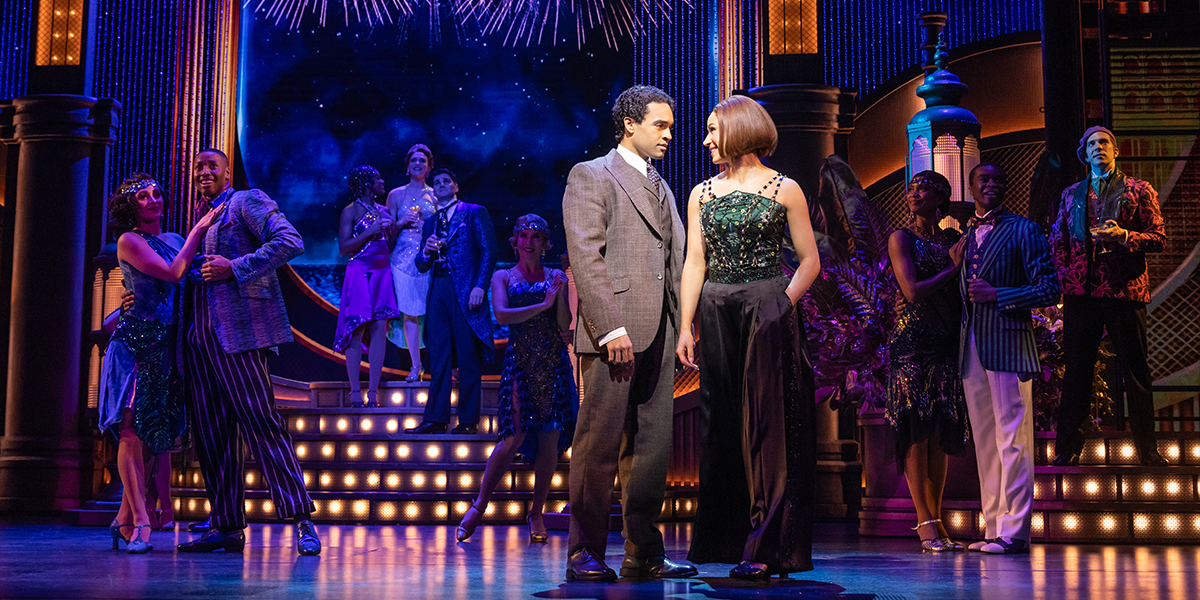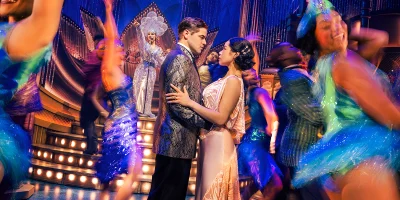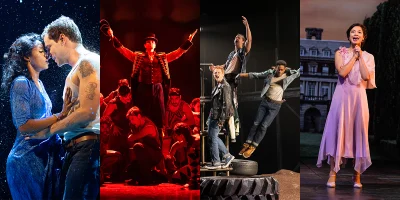
How ‘The Great Gatsby’ on Broadway pays homage to 1920s trends
The first Broadway musical adaptation of F. Scott Fitzgerald’s acclaimed 1925 novel includes nods to the decade’s fashion, art, music, dance, and more.
Hey, old sports! Between delicious Art Deco decor, flapper frocks, jazzy music, and Charleston dance steps, the 1920s got the green light to come roaring back in The Great Gatsby, the new musical that's turning the Broadway Theatre into a time capsule.
Based on F. Scott Fitzgerald’s iconic 1925 novel, the Jazz Age story explores the era’s excesses through one man’s pursuit of wealth and love. Like the novel, the show depicts mysterious millionaire Gatsby’s lavish parties, his doomed love for Daisy Buchanan, and the fatal fallout of his relentless chase.
The show by Jason Howland (music), Nathan Tysen (lyrics), and Kait Kerrigan (book) premiered in 2023 at the Paper Mill Playhouse in New Jersey. Audiences got a first look and listen to stars Jeremy Jordan and Eva Noblezada lead what Kerrigan calls “a great tragedy disguised as a great party” in a preface to her script. They also got to see how The Great Gatsby's recreates the Roaring Twenties.
In a director’s note for the New Jersey run, Marc Bruni said the creative team sought to explore the era in ways that “resonate across the generations.” Experience the new old Jazz Age at The Great Gatsby — here are all the ’20s nods in the musical.
Get The Great Gatsby tickets now.

1920s fashion
The Great Gatsby musical tips its hat to the Jazz Age through the costumes. There’s a “parade of clothes, all the greatest hits of the 1920s,” said costume designer Linda Cho.
Frisky, knee-length dresses defined women’s fashion: Dropped waists, beads, and embellishments provided the free-spirited look of the 1920s flapper. The trendy frocks pop up in Gatsby's party scenes, including an early one where all the costumes and sets are black and gold.
“It sets up the decadent world of the 1920s,” said Cho, who found inspiration for details in Art Deco influences of the designer Erté.
A later bash at Gatsby’s East Egg mansion sees party girls shaking it up in an eye-popping, Technicolor palette of flapper finery. “I wanted that to be an explosion of colors,” says Cho, adding that she strayed slightly from pure period design to make the costumes easier to dance in. “I like to call it Cheater ’20s.”
Men are also decked out in styles of the times. Their 1920s footwear included spectator shoes, characterized by contrasting colors on different parts of the shoe. Gatsby’s two-tone shoes, for one, reflect his duality as an ordinary man and the mogul he fashioned himself into.
“I’m not only looking at the clothes of the period; I'm also considering what stories they tell within each scene,” said Cho.

1920s art and decor
The Art Deco movement influenced Jazz Age interior design with its geometric shapes, bold lines, and mirrored and metallic finishes. Besides looking glamorous, reflective surfaces resonate in a story in which people could definitely use more introspection.
“Every stage picture is very important. You have to create a world for each scene,” said Cho, adding that she and scenic/projection designer Paul Tate dePoo III agree about that. Art Deco influences “are all over Paul’s set,” said Cho. “It’s so elegant, and it speaks to wealth. You see it in the archways and distinctive geometric patterns.”
Gatsby’s opulent library, lined floor-to-ceiling with books and shining like the Chrysler Building, is a prime example of ’20s decor — and a fitting spot for Gatsby to reveal his feelings for Daisy. “Everything I own, every party I’ve thrown,” he sings, “all the nights alone for her.”

1920s dance styles
The Charleston remains one of the most iconic dances of the Roaring Twenties. Marked by energetic footwork, wild kicks, swinging arms, and a syncopated rhythm, it captured the era’s exuberance and rebellion.
“In the 1920s, people started breaking apart and dancing alone,” Kelly said. “That had social implications. You could go out with a group of friends, or you could just be grooving by yourself. In our show, the people who are falling in love are dancing together.”
A rousing party scene at the start of the show explodes with Charleston moves. The dance has “jazz elements, which hearken back to West African dance,” said choreographer Dominique Kelley. “It’s very loose and limber... You can almost look like an outdoor balloon puppet.”
“It sets the tone,” Kelley added and said it’s one of several dances threading through the show.

1920s music
The Roaring Twenties saw the fast-rising popularity of jazz music. With its lively rhythms and improvisational elements, jazz became a signature sound of the era, influencing dance styles like the Charleston.
It’s no fluke the jazzy opening number at the Paper Mill is called “Roaring On.” “The first sound you hear is very ’20s,” said lyricist Nathan Tysen. “It’s a lot of clarinet and a lot of trumpet.” He and composer Jason Howland looked to "nod to the ’20s and yet not make the show a museum piece."
Get The Great Gatsby tickets now.
Photo credit: The Great Gatsby on Broadway. (Photos by Matthew Murphy)
Frequently asked questions
What is The Great Gatsby about?
Set during the Roaring Twenties, the glitzy party of a musical adaptation of the classic F. Scott Fitzgerald novel follows a millionaire named Jay Gatsby who's determined to win back his former love, Daisy Buchanan.
Where is The Great Gatsby playing?
The Great Gatsby is playing at Broadway Theatre. The theatre is located at 1681 Broadway, New York, 10019.
How long is The Great Gatsby?
The running time of The Great Gatsby is 2hr 30min. Incl. 1 intermission.
What's the age requirement for The Great Gatsby?
The recommended age for The Great Gatsby is Ages 10+. Children under 4 are not permitted in the theatre..
How do you book tickets for The Great Gatsby?
Book tickets for The Great Gatsby on New York Theatre Guide.
Who wrote The Great Gatsby on Broadway?
Jason Howland (Little Women) and Nathan Tysen (Ámelie) wrote the original score for The Great Gatsby on Broadway. Book writer Kait Kerrigan (The Unauthorized Autobiography of Samantha Brown) adapted the script from F. Scott Fitzgerald's 1925 book.
Who directed The Great Gatsby on Broadway?
The Great Gatsby is directed by Marc Bruni, best known for staging the Tony Award-winning Beautiful: The Carole King Musical.
Is The Great Gatsby appropriate for kids?
The Great Gatsby has some mature elements and themes, so this musical is recommended for ages 13 and older. Please note that children 4 and younger are not permitted in Broadway theatres.
Is The Great Gatsby good?
With time-honored source material, a top-tier cast of Broadway favorites, and lavish production design that captures the splendor of the 1920s, audiences are sure to feel like they're at one of Gatsby's vibrant parties at The Great Gatsby.
Originally published on



